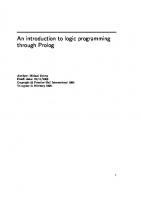An Introduction to Natural Language Processing Through Prolog 0582066220, 9780582066229
Research into Natural Language Processing - the use of computers to process language - has developed over the last coupl
371 51 2MB
English Pages 312 [315] Year 1998
Table of contents :
Cover
Title Page
Copyright Page
Table of Contents
Preface
PART I: Introduction
1 Natural Language Processing
1.1 Natural Language Interfaces
1.2 The Linguistic Application of NLP
1.3 NLP as a Tool for Linguistic Research
1.4 Further Reading
2 The Challenge of Natural Language Processing
2.1 Knowledge of Linguistic Structure
2.2 Ambiguity and Contextual Knowledge
2.3 The Process of Language Understanding
2.4 Psycholinguistics and NLP
2.5 Further Reading
PART II: The Fundamentals of Prolog Programming
3 Facts
3.1 Facts
3.2 Asking Simple Questions in Prolog
3.3 Compound Questions
3.4 Questions with Variables
3.5 Finding Alternative Answers: Backtracking
3.6 Using Variables in Facts
3.7 Further Reading
4 Rules and Complex Names
4.1 Rules
4.2 How Prolog Answers Questions Using Rules
4.3 Structured Objects
5 Lists and Recursive Rules
5.1 Lists
5.2 Recursive Rules
6 Developing Prolog Programs
6.1 The Meaning of Prolog Programs
6.2 Designing Programs
6.3 Laying Out Programs
6.4 Search Trees
6.5 Search Strategies
6.6 Tracing a Proof
6.7 Some Common Programming Errors
6.8 Further Reading
7 Built-in Predicates
7.1 Input and Output
7.2 fail
7.3 consult and reconsult
7.4 Modifying the Database
7.5 Defining Operators
7.6 The Cut
7.7 Program Listing
PART III: Natural Language Processing with Prolog
8 Finite State Grammars and Sentence Recognition
8.1 Sentence Frame Grammars
8.2 Parsing and Recognition Using a Sentence Frame Grammar
8.3 An Alternative Notation for Sentence Frame Grammars
8.4 A Finite State Grammar-based Recognisor
8.5 Extending the Range of Finite State Grammars
8.6 Further Reading
8.7 Program Listings
9 Recursive Transition Networks
9.1 Phrase Structure
9.2 Extending the Network Notation
9.3 An RTN-based Recognisor
9.4 Implementing an RTN Recognisor in Prolog
9.5 Extending the RTN Notation
9.6 Further Reading
9.7 Program Listings
10 Phrase Structure Grammars
10.1 Phrase Structure Grammars
10.2 A Simple Phrase Structure Recognisor
10.3 Directly Representing Phrase Structure Grammars in Prolog
10.4 Efficiency
10.5 Difference Lists
10.6 The Grammar Rule Notation
10.7 Further Reading
10.8 Program Listings
11 Definite Clause Grammars
11.1 Grammar Symbols as Complex Terms
11.2 Procedure Calls
11.3 Further Reading
11.4 Program Listings
12 Alternative Parsing Strategies
12.1 A Top-down Interpreter
12.2 Problems with Top-down Parsing
12.3 A Bottom-up Interpreter
12.4 A Left-corner Interpreter
12.5 Deterministic Parsing
12.6 Chart Parsing
12.7 Further Reading
12.8 Program Listings
Solutions to Exercises
Glossary of Terms
Index
Cover
Title Page
Copyright Page
Table of Contents
Preface
PART I: Introduction
1 Natural Language Processing
1.1 Natural Language Interfaces
1.2 The Linguistic Application of NLP
1.3 NLP as a Tool for Linguistic Research
1.4 Further Reading
2 The Challenge of Natural Language Processing
2.1 Knowledge of Linguistic Structure
2.2 Ambiguity and Contextual Knowledge
2.3 The Process of Language Understanding
2.4 Psycholinguistics and NLP
2.5 Further Reading
PART II: The Fundamentals of Prolog Programming
3 Facts
3.1 Facts
3.2 Asking Simple Questions in Prolog
3.3 Compound Questions
3.4 Questions with Variables
3.5 Finding Alternative Answers: Backtracking
3.6 Using Variables in Facts
3.7 Further Reading
4 Rules and Complex Names
4.1 Rules
4.2 How Prolog Answers Questions Using Rules
4.3 Structured Objects
5 Lists and Recursive Rules
5.1 Lists
5.2 Recursive Rules
6 Developing Prolog Programs
6.1 The Meaning of Prolog Programs
6.2 Designing Programs
6.3 Laying Out Programs
6.4 Search Trees
6.5 Search Strategies
6.6 Tracing a Proof
6.7 Some Common Programming Errors
6.8 Further Reading
7 Built-in Predicates
7.1 Input and Output
7.2 fail
7.3 consult and reconsult
7.4 Modifying the Database
7.5 Defining Operators
7.6 The Cut
7.7 Program Listing
PART III: Natural Language Processing with Prolog
8 Finite State Grammars and Sentence Recognition
8.1 Sentence Frame Grammars
8.2 Parsing and Recognition Using a Sentence Frame Grammar
8.3 An Alternative Notation for Sentence Frame Grammars
8.4 A Finite State Grammar-based Recognisor
8.5 Extending the Range of Finite State Grammars
8.6 Further Reading
8.7 Program Listings
9 Recursive Transition Networks
9.1 Phrase Structure
9.2 Extending the Network Notation
9.3 An RTN-based Recognisor
9.4 Implementing an RTN Recognisor in Prolog
9.5 Extending the RTN Notation
9.6 Further Reading
9.7 Program Listings
10 Phrase Structure Grammars
10.1 Phrase Structure Grammars
10.2 A Simple Phrase Structure Recognisor
10.3 Directly Representing Phrase Structure Grammars in Prolog
10.4 Efficiency
10.5 Difference Lists
10.6 The Grammar Rule Notation
10.7 Further Reading
10.8 Program Listings
11 Definite Clause Grammars
11.1 Grammar Symbols as Complex Terms
11.2 Procedure Calls
11.3 Further Reading
11.4 Program Listings
12 Alternative Parsing Strategies
12.1 A Top-down Interpreter
12.2 Problems with Top-down Parsing
12.3 A Bottom-up Interpreter
12.4 A Left-corner Interpreter
12.5 Deterministic Parsing
12.6 Chart Parsing
12.7 Further Reading
12.8 Program Listings
Solutions to Exercises
Glossary of Terms
Index





![Introduction to Natural Language Processing (NLP) [Illustrated]
0262042843, 9780262042840](https://ebin.pub/img/200x200/introduction-to-natural-language-processing-nlp-illustrated-0262042843-9780262042840.jpg)
![Speech and Language Processing An Introduction to Natural Language Processing, Computational Linguistics, and Speech Recognition [3 ed.]](https://ebin.pub/img/200x200/speech-and-language-processing-an-introduction-to-natural-language-processing-computational-linguistics-and-speech-recognition-3nbsped.jpg)

![An Introduction to Logic Programming Through Prolog [free web version (1996) ed.]
0135360471, 9780135360477](https://ebin.pub/img/200x200/an-introduction-to-logic-programming-through-prolog-free-web-version-1996nbsped-0135360471-9780135360477.jpg)

